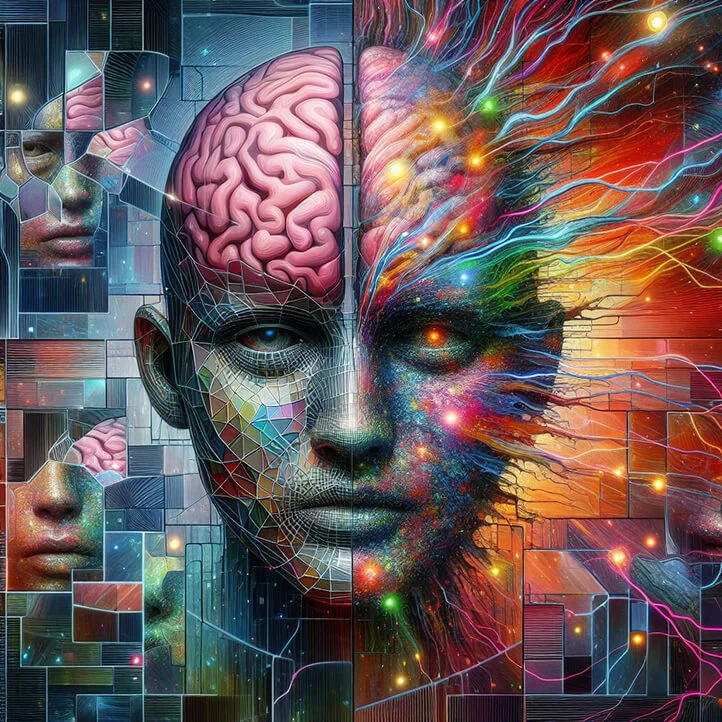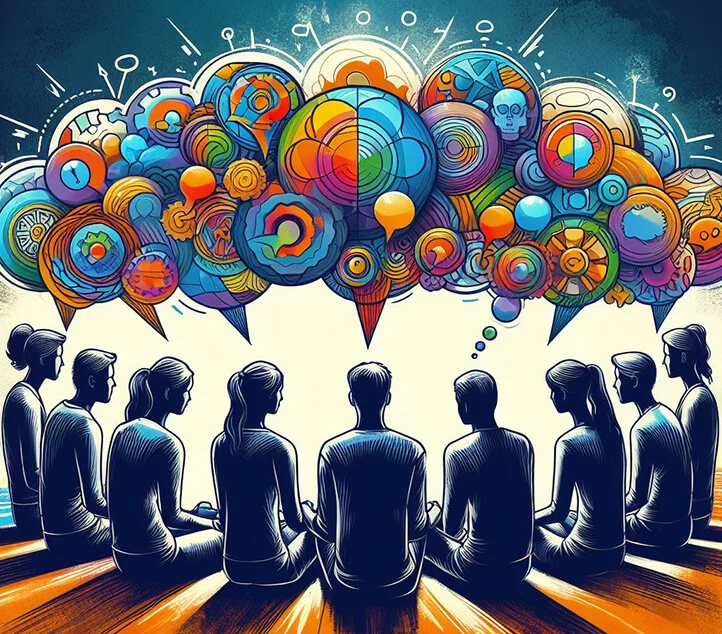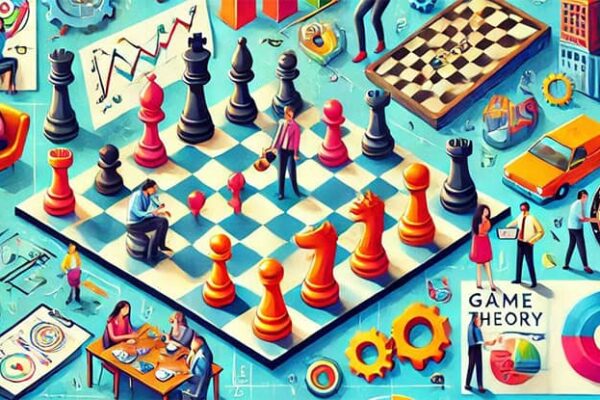Psychology is the science that studies the human mind and behavior. It helps us understand why people think, feel, and act in certain ways. Understanding the human psyche is essential for improving interpersonal relationships, increasing productivity, and achieving personal well-being.
In this article, I will discuss some of the most interesting facts about human psychology that will help you better understand yourself and others.

Perception and Cognitive Biases
Perception is the process by which our brain organizes and interprets sensory information from the environment. It is a fundamental psychological process underlying our interactions with the world and decision-making. However, our perception does not always accurately reflect reality. It is influenced by various cognitive biases, or systematic thinking errors, that can lead to incorrect judgments and decisions.
Cognitive biases arise for many reasons, including limited cognitive resources, emotional biases, and heuristics (simplified decision-making rules). While they help us quickly process information and make decisions in complex situations, these biases can also lead to errors in judgments and conclusions.
Understanding these phenomena is crucial for improving the accuracy of our perception, making more informed decisions, and avoiding mistakes that can have serious consequences.
Mere Exposure Effect
The mere exposure effect is the tendency of people to develop a preference for objects or people they frequently encounter. The more we see something, the more familiar and attractive it becomes. This effect explains why we tend to prefer certain brands or names we frequently see in advertisements.
Studies have shown that this effect works even with subliminal exposure (below the threshold of perception), where the stimulus is presented so quickly that the person is not aware of its presence. Additionally, the mere exposure effect can influence not only preferences but also judgments of credibility and reliability of information.
Anchoring Effect
The anchoring effect is the tendency of people to rely on initial information, or “anchor,” when making decisions. For example, if someone is offered a product initially priced at $100 and then the price is reduced to $75, they are more likely to perceive the second price as more attractive than if they were offered $75 right away.
This effect can be used in negotiations, marketing, and other situations where it is necessary to influence decision-making. By setting a high “anchor” price or value, you establish a reference point that will influence subsequent evaluations and decisions.
The anchoring effect also occurs in everyday life, where people assess situations based on arbitrary initial values or information obtained earlier.
Confirmation Bias
Confirmation bias is the tendency of people to seek, interpret, and remember information in ways that confirm their existing beliefs and expectations. This can lead to bias and erroneous conclusions because we tend to ignore or dismiss information that contradicts our views.
For example, people who believe in conspiracy theories are more likely to pay attention to and remember facts that support their beliefs while ignoring or rejecting refutations. This bias can be particularly problematic in political and ideological debates, where people often reject information that contradicts their beliefs.
To overcome confirmation bias, it is important to develop critical thinking, be open to alternative perspectives, and actively seek information that contradicts our beliefs. It is also helpful to consider situations from different angles and strive to be objective.
Blind Spot Effect
The blind spot effect refers to people’s tendency not to notice obvious things right in front of them. This phenomenon is related to limited cognitive resources and selective attention to certain aspects of the environment.
One classic example of the blind spot effect is the “invisible gorilla” experiment. In this experiment, participants watched a video of people passing a basketball to each other. Their task was to focus on counting the passes. In the middle of the video, a person in a gorilla costume walked through the scene, but many participants failed to notice it as they were entirely focused on counting the passes.
Understanding this effect is important in various fields, such as driving, workplace safety, and decision-making. Being aware of our cognitive limitations and training mindfulness can help overcome the blind spot effect and avoid serious errors.

Emotions and Motivation
Emotions are a fundamental part of the human experience, profoundly influencing our thinking, behavior, and decision-making. They act as internal signals, helping us respond to various situations and life stimuli. Joy, fear, anger, sadness—all these emotions play a crucial role in shaping our perception of the world and our interaction with it.
Motivation, on the other hand, refers to internal and external factors that drive us to act and direct our behavior. It is the force that compels us to pursue certain goals, meet needs, and overcome obstacles in pursuit of desired outcomes.
Emotions and motivation are closely linked and mutually influence each other. Our emotions can motivate us to take specific actions, while our motives, in turn, can trigger different emotional responses. For example, fear can motivate us to avoid dangerous situations, and achieving an important goal can evoke feelings of pride and joy.
The Link Between Emotions and Memory
Emotions play a key role in the formation of memories. Events associated with strong emotions, such as joy, fear, or sadness, are remembered better than neutral events. This is because emotions activate certain areas of the brain that help encode and consolidate memories.
Research has shown that the amygdala, part of the brain’s limbic system, plays a key role in processing emotional information and forming emotional memories. During intense emotional experiences, the amygdala becomes activated, enhancing the processes of encoding and memory consolidation.
This connection between emotions and memory has both positive and negative consequences. On the one hand, emotionally significant events are remembered better, which is useful for learning and decision-making. On the other hand, traumatic or very negative emotional experiences can lead to intrusive memories and post-traumatic stress disorder.
Understanding this link can help develop strategies for improving memory, such as associating new information with emotional experiences or using mnemonic techniques based on emotions.
The Impact of Stress on Decision-Making
When we are under stress, our brain releases hormones such as cortisol, which can affect cognitive functions, including attention, memory, and the ability to make rational decisions. As a result, we may make impulsive or poorly thought-out decisions.
Research has shown that acute stress activates the amygdala, the part of the brain responsible for processing emotions and triggering the “fight or flight” response. This can impair the functions of the prefrontal cortex, the area of the brain responsible for planning, decision-making, and impulse control.
Chronic stress can also negatively affect decision-making by depleting cognitive resources and reducing the ability to focus and process information. To improve decision-making, it is important to learn to manage stress through methods such as meditation, physical exercise, and prioritization.
Moreover, being aware of the impact of stress on decision-making can help people be more cautious and thoughtful when making important decisions in stressful situations. Sometimes it is helpful to delay making a decision or involve others to obtain objective feedback.
Placebo Effect
The placebo effect is a phenomenon where people experience an improvement in symptoms or health after taking an inert “dummy” medication that they believe to be real. This effect demonstrates the power of beliefs and expectations in influencing our health and well-being.
Research has shown that the placebo effect can be quite significant and influence various physiological processes in the body, such as pain levels, anxiety, depression and even immune response. This is because the expectation of a positive effect activates specific areas of the brain related to pain processing, emotions, and reward.
Interestingly, the placebo effect can be enhanced or weakened by various factors, such as the color and shape of the pill, the status and persuasiveness of the doctor, and the patient’s previous experiences. This underscores the power of psychological factors in shaping our perception and response to treatment.
Although the placebo effect has been observed in medical studies, it can also manifest in other areas, such as productivity, sports, and personal effectiveness. Understanding this phenomenon can help people harness the power of their beliefs and expectations to improve well-being and achieve goals.
However, it is important to remember that the placebo effect does not replace the need for real medical treatment in cases of serious illnesses or conditions. It should be seen as an additional factor that can enhance the effectiveness of treatment.
Halo Effect and Contrast Effect
- The halo effect is the tendency of people to form an overall impression of a person based on one or a few positive characteristics. For example, if someone is attractive or successful, we may assume they are also intelligent and friendly, even if we have no evidence of this.
- The contrast effect is the tendency of people to evaluate a person or object more negatively when comparing them to someone or something exceptionally positive.
These effects can arise in various situations, such as hiring decisions, court trials, interpersonal relationships, and product or service evaluations. We tend to form general impressions based on limited information, ignoring other important details.
The halo and contrast effects can lead to bias and erroneous judgments, as we overlook other important aspects of a person’s character, situation, or product. To avoid these biases, it is important to try to assess people, situations, and objects based on all available facts and evidence rather than limited information or first impressions.

Social Psychology
Humans are social beings, and our behavior, thoughts, and emotions are largely shaped by social factors and interpersonal interactions. Social psychology is the branch of psychology that studies these influences, as well as how individual behavior and thinking are shaped within a social context.
One of the key ideas in social psychology is that our behavior is often determined not only by our personality traits and individual preferences but also by situational factors, social norms, and the influence of others. We tend to obey authority, conform to group pressure, and adapt our behavior to the expectations of those around us.
Milgram’s Experiment
In the famous Milgram experiment conducted in 1961, participants were asked to follow the instructions of an experimenter and administer electric shocks to a “learner” for incorrect answers. The experiment demonstrated that many people are inclined to obey authority figures, even when their actions harm others.
In this experiment, volunteers believed they were delivering real electric shocks to the “learner” (an actor) for each incorrect response. Despite the cries and complaints of the “learner,” most participants continued to increase the shock voltage at the experimenter’s command.
These results were shocking and revealed how powerful authority and conformity can be. People tend to follow the orders of authority figures even when those orders contradict their moral beliefs and cause harm to others.
Milgram’s experiment has important implications for understanding social behavior, ethics, and decision-making in various contexts, such as military conflicts, authoritarian regimes, and corporate scandals. It underscores the need to develop critical thinking and the ability to resist unethical commands or actions.
The Crowd Effect and Groupthink
The crowd effect refers to the phenomenon where people in a crowd may exhibit behavior different from their usual individual behavior. In a crowd, people tend to experience a sense of anonymity, diffused responsibility, and emotional contagion, which can lead to aggressive, impulsive, or irrational actions.
This effect can manifest in various situations, such as riots, stampedes at concerts or sports events, and even in online environments like social media, where individuals may feel part of a virtual crowd.
A related phenomenon is groupthink—a tendency in cohesive groups to suppress critical thinking and alternative viewpoints in the pursuit of harmony and unity. Group members may ignore or dismiss contradictory information and make risky or irrational decisions to maintain group solidarity.
Groupthink can have serious consequences in organizations, governments, and other groups where important decisions are made. To avoid this phenomenon, it is essential to encourage diverse opinions and open discussion of alternative ideas.
The Stanford Prison Experiment
In the famous Stanford prison experiment conducted in 1971, college students were randomly assigned the roles of “guards” and “prisoners” in a simulated prison environment. The experiment was supposed to last two weeks but was terminated after only six days due to the situation spiraling out of control.
The “guards” quickly adopted authoritarian and abusive behaviors, while the “prisoners” began to show signs of emotional distress and helplessness. The situation became so intense that some participants experienced serious psychological issues.
This experiment demonstrated how situational factors and social roles can radically change human behavior. People who were initially normal and rational quickly adopted extreme and destructive behaviors consistent with their assigned roles in the experiment.
The results of the Stanford experiment have important implications for understanding social dynamics in prisons, the military, corporations, and other hierarchical systems. They highlight the need to be aware of situational influences on human behavior and the importance of creating systems with proper checks and balances to prevent abuse of power.
The Attractiveness Effect and Stereotypes of Attractiveness
The attractiveness effect is the tendency for people to attribute more positive qualities to physically attractive individuals. Research has shown that attractive people are often perceived as more intelligent, successful, friendly, and competent, even when there is no real evidence for these qualities.
This effect can influence various aspects of life, such as employment, court trials, interpersonal relationships, and even political elections. People tend to favor attractive candidates or partners regardless of their actual qualities or abilities.
A related phenomenon is attractiveness stereotypes—widely held beliefs about the personality traits and social roles associated with physical attractiveness. For example, there is a stereotype that attractive women are more seductive but less competent in professional settings, while attractive men are perceived as more successful and confident.
These stereotypes can lead to bias and discrimination, as they shape expectations and judgments about individuals based on their appearance rather than their actual qualities or achievements. It is important to be aware of the impact of the attractiveness effect and related stereotypes in order to make more objective and fair decisions in various life situations.

Personality and Individual Differences
Each person is unique, and this uniqueness is expressed through our personality traits, behaviors, thinking patterns, and ways of interacting with the world around us. The study of personality and individual differences is one of the key areas of psychology that helps us understand what makes each of us special and how these differences affect our life experiences.
Personality is a unique combination of traits, qualities, and patterns of behavior that determine how a person thinks, feels, and acts in various situations. These traits may include aspects such as extraversion, neuroticism, openness to experience, conscientiousness, and agreeableness. They are shaped by a combination of genetic factors, the environment, and life experiences.
Individual differences are variations in psychological characteristics, such as personality traits, cognitive abilities, interests, values, and motivation, that make each person unique. These differences can influence our preferences, career choices, interpersonal relationships, and coping strategies.
The Big Five Personality Theory
The Big Five personality traits theory is a model that describes five major dimensions of personality:
- Extraversion: The tendency to be sociable, energetic, and engaged in social interactions.
- Agreeableness: The tendency to be trusting, cooperative, and caring toward others.
- Conscientiousness: The degree of organization, self-discipline, and goal orientation.
- Neuroticism: The tendency toward emotional instability, anxiety, and negative emotions.
- Openness to experience: Curiosity, creativity, and willingness to embrace new ideas and values.
These traits help explain differences in behavior, emotions, and interactions between people. They can influence career choices, interpersonal relationships, coping with stress, and many other aspects of life.
It is important to note that personality traits exist on a spectrum, not in strict categories. People may have varying combinations of these traits to different degrees. Additionally, personality traits are not entirely stable and can change over time due to life experiences.
Knowing your personality traits and those of others can help you better understand motivation, values, and behavior, and adapt communication and interaction strategies accordingly. However, it is important to avoid stereotyping and making judgments based solely on personality traits and instead consider the unique characteristics of each individual.
Left/Right Brain Hemispheres and Their Functions
The left and right hemispheres of the brain have different functions. The left hemisphere is typically associated with analytical and logical thinking, while the right hemisphere is linked to creative and spatial thinking. However, these functions are not completely separate, and both hemispheres interact and complement each other.
1. The left hemisphere is responsible for:
- Language abilities (speech, reading, writing)
- Logical and analytical thinking
- Mathematical calculations
- Sequence and order
2. The right hemisphere is responsible for:
- Spatial perception
- Creative and imaginative thinking
- Facial recognition and emotional processing
- Musical and artistic abilities
Studies have shown that people with more balanced activity between both hemispheres tend to have higher levels of creativity and problem-solving skills. This highlights the importance of interaction and integration of functions from both hemispheres for optimal brain performance.
Understanding the specialization of the hemispheres helps in learning and skill development. To develop analytical and linguistic abilities, it is useful to use strategies that engage the left hemisphere, while for solving creative and spatial tasks, methods that involve the right hemisphere are more effective.
However, it is important to remember that these differences are general tendencies, and each person is unique. There are no “left-brained” or “right-brained” people in a literal sense—most people use both hemispheres of the brain to varying degrees.
Introversion/Extraversion and Their Influence on Behavior
Introversion and extraversion are two opposite personality traits that influence people’s social behavior and needs. Introverts are more calm, reserved, and prefer solitude, while extroverts are more sociable, energetic, and inclined toward social interaction.
1. Introverts prefer:
- Spending time alone or with a small circle of close people
- Thinking through ideas and decisions before speaking
- Quiet and calm environments
- Focusing on the inner world of thoughts and ideas
2. Extroverts prefer:
- Active social interaction and group activities
- Expressing their thoughts and ideas out loud
- Energetic and stimulating environments
- Focusing on the external world, surrounding people, and events
These differences can influence career choices, communication styles, and ways of gaining energy. Introverts feel more comfortable in quieter, independent professions, while extroverts thrive in socially active and dynamic environments.
It is important to understand that introversion/extraversion is not a strict distinction. Most people possess traits of both introverts and extroverts to varying degrees.
Additionally, it is essential to avoid stereotyping and judgments based solely on these traits. Both introverts and extroverts can be successful, creative, and effective in various areas of life if they find suitable strategies and environments for themselves.




